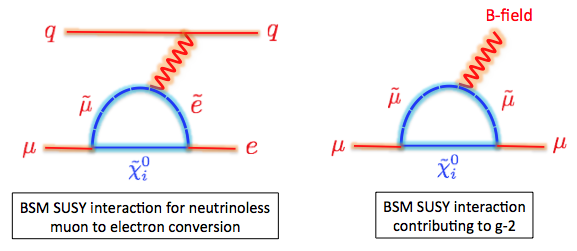
C. Alvarez-Garcia, R. Appleby, M. Gersabeck, A. Keshavarzi, M. Lancaster, G. Sweetmore
At the LHC experiments, ATLAS and CMS, evidence for new particles and interactions beyond the Standard Model (BSM) is being sought by looking for the direct production of new particles. Such searches are limited by the LHC beam energy and present limits on Supersymmetry (SUSY) in the non-colour sector extend to masses of approximately 0.5-1.0 TeV.
An alternative approach is to exploit the uncertainty principle and look for the effect of virtual particles which potentially allows much higher mass scales to be probed. In the quark sector this is being pursued by LHCb and NA62 and in the charged lepton sector this is being pursued by two different types of muon experiment.
The first is seeking to see neutrinoless decays of the muon which only occur at an unobservable rate (O(10-50)) in the Standard Model (SM) such that any observation would be evidence of BSM physics. At Manchester we are part of the Fermilab Mu2e experiment that is seeking to extend the search for charged lepton flavour violation by 4 orders of magnitude.
The second method is to measure a quantity that is very precisely predicted in the SM and look for a deviation in the value. We are pursuing this strategy as part of the Fermilab g-2 experiment where we are seeking to make the world's most precise accelerator measurement: that of the muon's magnetic moment with a precision of 0.14 parts per million. The analysis of the first dataset accumulated in 2018 was published in 2021 and in combination with a previous measurement at Brookhaven, has determined a (g-2) value which disagrees with the SM prediction by 4.2 standard deviations. The analysis of the data accumulated after 2018 and refinements in the SM prediction will enable us to confirm or not whether we are indeed observing new physics not encompassed in the SM. The same experiment will also be able to search for a muon electric dipole moment with a sensitivity more than 10 ten times better than previous experiments.
In certain classes of model these two measurements are closely related (see the above Feynman diagrams). For example in SUSY they both proceed through the exchange of a neutralino and both measurements are required to pin down the model parameters. The muon magnetic moment indicates the mass scale of the new physics whereas the muon to electron conversion is determined by both the mass scale and the slepton mixing. For large slepton mixing the muon to electron conversion process has a sensitivity to mass scales far beyond the LHC.